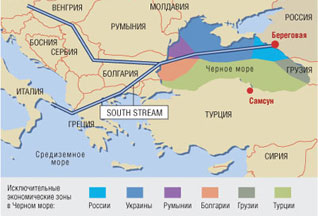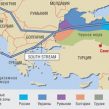
AUSTRIAN GOVERNMENT, OMV JOINING GAZPROM’S SOUTH STREAM PROJECT, UNDERCUT NABUCCO
Publication: Eurasia Daily Monitor Volume: 5 Issue: 110
By:

The Austrian government and the OMV oil and gas company are about to join Russia’s South Stream gas pipeline project, Gazprom Vice-President Aleksandr Medvedev announced during the St. Petersburg Economic Forum on June 7. Gazprom’s South Stream is a rival to the US-backed, EU top-priority Nabucco pipeline project, which would bring Caspian gas via Turkey to Europe.
Implying that negotiations with the Austrians have already taken place, Medvedev told journalists that a Russian-Austrian intergovernmental agreement on the project will “be signed very soon. OMV and Gazprom are to form a joint company that would operate the planned South Stream pipeline’s section to be built on Austrian territory. The line would deliver Gazprom’s gas to the Baumgarten terminal and gas hub near Vienna (Interfax, RossBusinessConsulting, Thomson Financial, Reuters, June 7).
OMV spokeswoman Bettina Gneisz indirectly confirmed Medvedev’s announcement: “There is nothing concrete to report at this point. While the Nabucco project remains our number one priority, it makes sense for one of South Stream’s routes to pass through Baumgarten” (Thomson Financial, June 7). The wording seems to imply that final details remain to be added to the agreement on the Russian-Austrian project. The phrase that Nabucco remains the first choice is also being used by the Bulgarian government, as an excuse for its defection since February 2008 from Nabucco to South Stream.
OMV is one-third state-owned and enjoys traditionally close, if informal, relations with the Austrian government. Economics Minister Martin Bartenstein, returning from Russia, confirmed in more general terms, “We are ready and eager to negotiate such an intergovernmental agreement” (APA, June 9; Die Presse, June 10).
Austria has long been receiving massive volumes of gas from Russia via Ukraine and Slovakia, for national consumption as well as for transit to Germany and Italy. The Baumgarten terminal handles those volumes incoming from the east. Medvedev’s announcement, however, indicates that Gazprom intends to expand into Austria from the south as well, via Hungary, through an extension of the planned South Stream. That would also converge on Baumgarten for further distribution and transit.
Hungary’s Socialist government joined South Stream by signing an intergovernmental agreement in Moscow in February 2008. That defection has enabled Gazprom to target Austria with South Stream from Hungary. Unlike the government, Hungary’s privately-owned MOL company remains loyal to the Nabucco project.
Baumgarten was the originally designated terminal of the Nabucco pipeline project. In a blow to Nabucco, however, OMV has turned the terminal into a 50 percent-50 percent joint venture with Gazprom under agreements signed in November 2007 and January 2008. Gazprom has enticed the Austrian government and OMV by promising to expand Baumgarten, from the third-largest to the largest gas hub and trading platform in continental Europe. Redesignated as the Central European Gas Hub (CEGH), Baumgarten is supposed to see the construction of more storage sites for Gazprom-delivered gas.
OMV has resorted to damage limitation by claiming that the joint ownership with Gazprom applies only to Baumgarten’s trading platform, i.e., the place of virtually conducted transactions, but not to the storage center itself. OMV’s assurances that it retains full ownership may well be correct about the existing storage site; but the vast storage sites, supposedly to be built around Baumgarten with and for Gazprom gas, are another matter. It would be inconsistent with Gazprom’s practices to allow full ownership by the recipient country of new storage sites to be built for additional volumes of Gazprom-delivered gas. In such situations, Gazprom insists on joint ownership of the storage sites.
OMV is further undercutting Nabucco by accepting to share the pipeline’s capacity with Gazprom for Russian gas, or Turkmen gas resold as “Russian” gas by Gazprom. Information material distributed recently by OMV shows Gazprom’s Blue Stream pipeline, across the seabed of the Black Sea to Turkey, connecting with Nabucco near Ankara as one of the “existing/possible supply routes to the Nabucco Pipeline” (May 2008). Blue Stream carries Russian and Central Asian gas for Gazprom. Some OMV executives, double-hatted as Nabucco managers, had already publicly broached in 2007 the idea of sharing Nabucco with Gazprom.
This would, however, defeat the project’s strategic rationale, which is to reduce European dependence on Russian gas and open direct access for Central Asian gas to Europe. The U.S. Special Envoy for EU and Energy Affairs, C. Boyden Gray, reaffirmed while in Budapest on June 9 that Washington was against involvement of Gazprom’s gas in the Nabucco project, as such involvement would contradict the project’s main aims (MTI, Itar-Tass, June 9). The weak point in the U.S. position, however, is to rule out Iranian gas, which was the main source originally intended for the Nabucco project.
In sum, OMV seems willing to compromise the Nabucco project in three ways: by apparently agreeing to open Austria for Gazprom’s rival project South Stream, by sharing the designated Nabucco terminal with Gazprom, and through its stated willingness to share the Nabucco pipeline’s capacity with the Gazprom monopoly.




